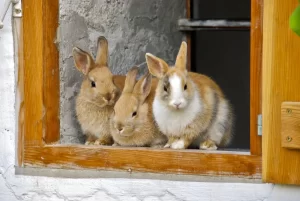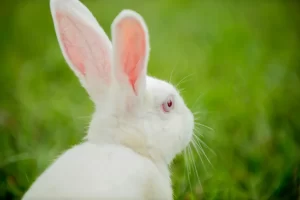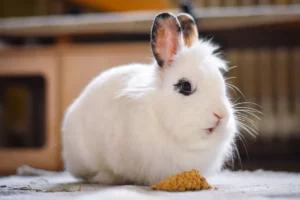Are you curious about the sleeping habits of rabbits? Do you ever wonder if they are more active during the day or at night? In this article, we will delve into the fascinating world of rabbit behavior and explore whether they are nocturnal or diurnal creatures.
By understanding their natural patterns and the factors that influence their activity, you will gain valuable insights on how to create a sleep-friendly environment for your furry friends.
Get ready to discover the secrets of the rabbit sleep-wake cycle!
In This Article
- 1 Key Takeaways
- 2 The Sleep-Wake Cycle of Rabbits
- 3 Rabbit Behavior Patterns: A Daytime Perspective
- 4 Exploring Rabbit Activity at Night
- 5 Factors Influencing Rabbit Activity Patterns
- 6 Do Rabbits Adjust Their Activity Based on Environment
- 7 How Light and Darkness Impact Rabbit Activity
- 8 The Relationship Between Rabbit Activity and Predators
- 9 Tips for Creating a Rabbit-Friendly Sleep Environment
- 10 Frequently Asked Questions
- 11 Conclusion
Key Takeaways
- Rabbits have a unique sleep pattern called polyphasic sleep with multiple short periods of sleep.
- Rabbits are crepuscular animals, most active during dawn and dusk.
- During the day, rabbits take short naps known as ‘catnaps’ with partially closed eyelids.
- At night, rabbits become more active, engaging in foraging and social behaviors.
The Sleep-Wake Cycle of Rabbits
Do you know if rabbits sleep with their eyes open?
It’s a common misconception that rabbits sleep with their eyes open, but this isn’t true. Rabbits have a unique sleep pattern that’s influenced by their circadian rhythm, which is their internal biological clock.
Rabbits are crepuscular animals, which means they’re most active during the dawn and dusk hours. During the day, rabbits tend to take short naps, known as ‘catnaps,’ where they may appear to be sleeping with their eyes open. However, their eyelids are actually partially closed, allowing them to be alert to any potential threats.
At night, rabbits become more active, engaging in foraging and social behaviors. Understanding the sleep patterns and circadian rhythm of rabbits is important for their overall well-being and providing them with a suitable environment.
Rabbit Behavior Patterns: A Daytime Perspective
Take note of the eating habits and social interactions of rabbits during the day to gain a better understanding of their behavior patterns.
Rabbits are known to be crepuscular animals, which means they’re most active during the twilight hours of dawn and dusk. However, they also exhibit certain behaviors during the day that can provide valuable insight into their daily routines.
In terms of feeding habits, rabbits are herbivores and consume a diet primarily consisting of grasses, hay, and leafy greens. During the day, they engage in grazing activities, nibbling on vegetation to fulfill their nutritional needs.
Socially, rabbits are social animals and thrive in the company of their own kind. They engage in various social interactions, such as grooming each other, playing, and communicating through body language and vocalizations.
Exploring Rabbit Activity at Night
You can observe the nocturnal activities of rabbits by observing their behavior at night. Rabbits, although commonly associated with being diurnal, actually exhibit some interesting nighttime behavior. Here are some key points to consider:
- Rabbits are crepuscular animals, meaning they’re most active during dawn and dusk.
- They’ve a unique sleep pattern called polyphasic sleep, which involves multiple short periods of sleep throughout the day and night.
During the night, rabbits tend to be more alert and active, engaging in activities such as foraging, grooming, and exploring their surroundings. They’ve excellent night vision, thanks to their large eyes and the presence of a reflective layer behind the retina.
Rabbits may also exhibit territorial behavior at night, marking their territory and defending it from intruders.
Understanding rabbits’ nighttime behavior and sleep patterns can help provide better care and meet their needs, ensuring their well-being.
Factors Influencing Rabbit Activity Patterns
One factor to consider when examining rabbit activity patterns is the effect of light on their behavior during different times of the day. Rabbits are known to be crepuscular, meaning they’re most active during dawn and dusk. This is influenced by the natural light cycle, as rabbits have evolved to forage and feed during these low-light periods to avoid predators.
However, other factors also play a role in their activity patterns. The availability of food resources is a key factor influencing rabbit feeding habits. Rabbits are opportunistic herbivores, and their activity levels will vary depending on the abundance and quality of food sources.
Additionally, temperature can have a significant effect on rabbit activity. They’re more active during cooler temperatures, as extreme heat can cause them to seek shelter and reduce their feeding and movement.
Understanding these factors is crucial for providing optimal care and management for rabbits, ensuring their well-being and promoting their natural behavior.
Do Rabbits Adjust Their Activity Based on Environment
Do rabbits adjust their activity based on their environment?
The activity patterns of rabbits can indeed be influenced by their surroundings. Rabbits living in urban areas, where there’s an abundance of human activity and noise, tend to be more active during the night. They’ve adapted to the presence of artificial light and are less likely to be disturbed by human presence during these hours.
On the other hand, rabbits in rural areas, with less human interference and noise, are more active during the day. They’ve adapted to the natural light cycles and feel safer foraging and exploring during daylight hours.
This adjustment in activity patterns allows rabbits to maximize their chances of survival in different environments.
- Rabbits in urban areas are more active at night.
- Rabbits in rural areas are more active during the day.
- Urban rabbits have adapted to artificial light.
- Rural rabbits have adapted to natural light cycles.
- Adjusting activity patterns allows rabbits to maximize survival chances.
How Light and Darkness Impact Rabbit Activity
Light and darkness both affect rabbit activity, as they are more active at night when it is dark and during the day when it is light. This behavior is regulated by their circadian rhythm, which is a biological process that helps organisms adapt to the daily cycle of light and darkness. Rabbits have evolved to be crepuscular, meaning they are most active during dawn and dusk. However, the influence of artificial lighting can disrupt their natural activity patterns. Research has shown that exposure to constant artificial light can disrupt their circadian rhythm, leading to changes in behavior and health problems. To illustrate this, let’s take a look at the table below, which compares the activity levels of rabbits in natural light conditions versus those exposed to artificial lighting:
| Light Condition | Rabbit Activity |
|---|---|
| Natural Light | High |
| Artificial Lighting | Decreased |
As you can see, artificial lighting has a negative impact on rabbit activity. It is important for those serving rabbits to be mindful of their lighting environment and provide appropriate conditions to support their natural circadian rhythm.
The Relationship Between Rabbit Activity and Predators
If you want to understand the relationship between rabbit activity and predators, it’s important to consider the factors that influence their behavior.
Rabbits are prey animals, and their behavior is strongly influenced by the presence of predators. Here are some key points to consider:
- Predator prey dynamics: Rabbits have evolved to be highly vigilant and responsive to potential threats from predators. They’ve developed various strategies to avoid being caught, such as freezing in place or fleeing at high speeds.
- Impact of predator presence on rabbit behavior: When rabbits detect the presence of predators, their activity levels decrease significantly. They become more cautious and tend to hide in burrows or dense vegetation to avoid being detected.
- Sensory cues: Rabbits rely on their acute senses, including hearing and smell, to detect the presence of predators. They’re particularly sensitive to sudden movements and unfamiliar sounds.
- Time of day: While rabbits are generally more active during dawn and dusk, the presence of predators can disrupt their normal activity patterns. They may become more active during the night to minimize the risk of encountering predators.
- Habitat characteristics: The availability of suitable cover, such as dense vegetation or burrows, can greatly influence rabbit behavior in the presence of predators. It provides them with a safe place to hide and increases their chances of survival.
Understanding the relationship between rabbit activity and predators is crucial for conservation efforts and managing predator-prey dynamics in natural ecosystems. By studying these interactions, scientists can gain valuable insights into the behavior of both predators and prey, ultimately aiding in the preservation of biodiversity.
Tips for Creating a Rabbit-Friendly Sleep Environment
Make sure to provide your rabbit with a cozy sleeping area that includes soft bedding and a quiet atmosphere for their optimal rest.
Creating a calm and comfortable sleep space for rabbits is essential for their overall well-being and health. Rabbits are crepuscular animals, meaning they are most active during dawn and dusk. To establish a consistent sleep routine for rabbits, it is important to mimic their natural environment as much as possible.
This can be achieved by setting up a designated sleep area with comfortable bedding such as hay or straw. Additionally, ensuring a quiet and dimly lit environment will help promote relaxation and restful sleep.
Avoid placing the sleep area near noisy appliances or areas with constant foot traffic. By providing a peaceful sleep space, you are helping your rabbit maintain a healthy sleep routine and promoting their overall happiness and comfort.
| Tips for Creating a Rabbit-Friendly Sleep Environment |
|---|
| 1. Provide a cozy sleeping area with soft bedding |
| 2. Ensure a quiet and dimly lit atmosphere |
| 3. Avoid placing the sleep area near noisy appliances |
| 4. Establish a consistent routine for sleep |
Frequently Asked Questions
What Is the Average Lifespan of a Rabbit?
The average lifespan of a rabbit is influenced by various factors, such as breed, diet, and living conditions. It is important to consider rabbit breeding habits and be aware of common health issues to ensure their well-being.
How Do Rabbits Communicate With Each Other?
Rabbits communicate through a variety of vocalizations and body language. They use different sounds to express emotions and convey messages to other rabbits. Their body movements and postures also play a crucial role in communication.
What Is the Difference Between a Wild Rabbit and a Domesticated Rabbit’s Sleep Patterns?
Wild and domesticated rabbits have different sleep patterns. The impact of domestication on rabbit sleep is not fully understood. Research suggests that domesticated rabbits may have altered sleep patterns compared to their wild counterparts.
Can Rabbits See in the Dark?
Rabbits have remarkable night vision, with adaptations for low light conditions. Their large eyes, positioned on the sides of their head, allow for a wide field of view, perfect for spotting predators in the dark.
How Do Rabbits Protect Themselves From Predators at Night?
Rabbits protect themselves from predators at night by using their natural camouflage and seeking refuge in burrows. Their fur color blends with the surroundings, making it difficult for predators to spot them.
Conclusion
In conclusion, rabbits are crepuscular animals, meaning they’re most active during dawn and dusk. Their behavior patterns are influenced by various factors such as environment, light, darkness, and the presence of predators.
Creating a rabbit-friendly sleep environment is crucial to ensuring their well-being. By understanding the sleep-wake cycle and activity patterns of rabbits, we can better appreciate and accommodate their natural behavior in our homes or outdoor spaces.





